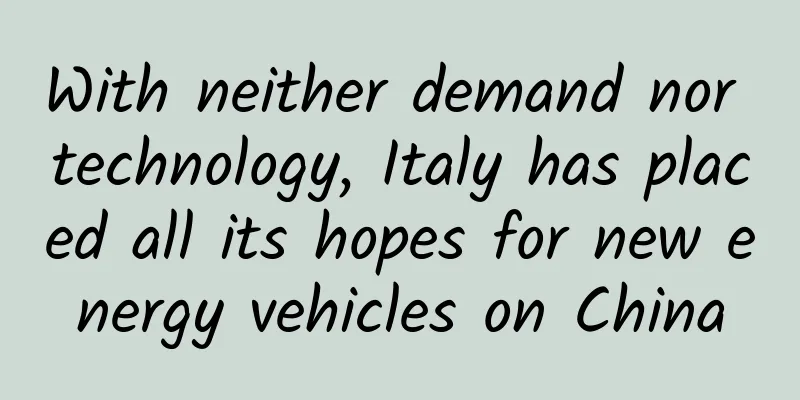With neither demand nor technology, Italy has placed all its hopes for new energy vehicles on China

|
Red wine, two Milans, a country that looks like a pair of high heels, the "flower" Bellucci, the leader of the five European pigs, and good at standing on the wrong side of the line... On the Chinese Internet, Italy is a country with a lot of jokes, and people nickname it "Yidaili". However, Italy is not as weak as imagined. As one of the four major industrial countries in Europe, Italy's economic foundation is still quite good. Take the automobile industry as an example. Italy is now the third largest automobile market in Europe, with Ferrari in Maranello, Lamborghini in Sant'Agata, Lancia in Bormio, Maserati and Pagani in Modena, and Fiat and Iveco in Turin. Think about it, China accounts for 30% of the global automobile market share and has so many world-renowned automobile brands? However, Italy's automobile industry is no longer what it used to be. Especially after the advent of the new energy era, Italy, a traditional automobile powerhouse, has fallen into a very embarrassing situation. We know that Europe is one of the earliest countries and regions in the world to propose the development of new energy vehicles. So, as a long-established European automobile power, how does Italy perform in the field of new energy vehicles? According to data released by the Italian Automobile Industry Association, in August 2024, total passenger car sales in Italy fell by 13.4%, of which sales of pure electric vehicles were only 2,605 units, a plunge of 36.1%. As a global automobile powerhouse, it is hard to believe that it is transforming when it sells 2,605 electric vehicles in a month. In fact, in the first quarter of 2024, Italy's electric vehicle sales fell by 18.5%, and the decline widened to 34.9% in the second quarter. In the first half of the year, the penetration rate of electric vehicles was only 3.9%. In 2023, the momentum of pure electric vehicles in Italy was still strong, with annual sales reaching 66,276 units, a year-on-year increase of 35.1%, and a market share of 4.2%. Judging from the growth rate, Italian electric vehicles were making great strides at the time. But just a few months later, electric vehicles in Italy returned to the pre-liberation era overnight and became a burden to the entire auto market. The "roller coaster" development trajectory proves one thing: the Italian new energy vehicle market has an unstable foundation and is not yet ready to participate in global competition. Italy's local automakers are relatively weak and unable to support the huge new energy transformation plan, so they need more financial support. On February 1, 2024, the Italian government announced that the amount of automobile ecological subsidies in 2024 will increase to 950 million euros, focusing on purchasing incentives for pure electric and plug-in hybrid vehicles, with a maximum subsidy of 13,750 euros. The 950 million euro subsidy may not sound like much, but Italy's annual car sales in 2023 will be around 1.56 million vehicles, so this policy will still boost the sales of electric vehicles. But the problem is that this policy has not been adhered to. Italian trade unions have publicly stated that the government's commitment to subsidize electric vehicles in 2024 has been postponed, which has become the main reason for the slowdown in demand for electric vehicles. Stellantis Group CEO Carlos Tavares publicly stated that Italy is one of the countries with the lowest share of electric vehicle sales in Western Europe, and its financial subsidy policy is not as generous as that of France and Germany. In addition to factors such as market demand and policies, there is another more important reason why Italy's new energy vehicle industry is struggling. That is, it has relatively large shortcomings in core technology, and therefore appears to be "lacking stamina." Taking power batteries as an example, among the top 10 global power battery installed capacity rankings from January to July 2024, 6 were Chinese manufacturers, 3 were from South Korea, and 1 was from Japan. All of them were occupied by China, Japan and South Korea, and European power battery manufacturers were completely marginalized. But Italy still wants to struggle. As early as 2020, Stellantis Group, Total Energy and Mercedes-Benz jointly established a power battery joint venture called ACC. According to the plan, the company will invest 7 billion euros to build three power battery super factories in France, Germany and Italy. It is expected to increase the production capacity to 120GWh by 2030, and at the same time conduct some forward-looking research on the new generation of high-performance batteries. However, as of today, only the French factory has been progressing smoothly, while the factories in Germany and Italy have been temporarily suspended by the Stellantis Group. In the view of the Stellantis Group, the demand for new energy vehicles in Germany and Italy has slowed down significantly, so cost savings are needed. This caused a fierce conflict between the Stellantis Group and the Italian government, and Italian Prime Minister Meroni directly accused the Stellantis Group of "deviating from Italy's national interests." This chaos proves that Italy, a traditional automobile powerhouse, is very vulnerable in its transition to new energy. It has spent all its budget before subsidies are used up, does not have core technologies, does not have strong risk resistance, and does not have strong and sustainable industrial policies. However, the Italian automobile industry represented by the Stellantis Group will not sit idly by. By 2025, the EU's strict new emission standards will be officially implemented. Therefore, despite all the obstacles, the Stellantis Group will still promote transformation. This time, the Stellantis Group has chosen a more personalized path: leveraging China's new energy vehicle industry to achieve transformation, and its approach is different from that of Volkswagen. In October last year, Stellantis Group spent 1.5 billion euros to acquire nearly 20% of the shares of China's new car manufacturer Leapmotor, and established a joint venture called "Leapmotor International" to be responsible for the development of Leapmotor's markets outside of China. Leapmotor is a second-tier brand among China's new car-making forces, but it has emerged from China's most competitive new energy market. It has a complete set of core technologies for new energy vehicles and has no problem exporting technology to the Stellantis Group. In July 2024, less than a year after the cooperation between the two parties, Tang Weishi said that the first batch of 800 Leapmotor vehicles shipped to Europe had been on board. At the same time, the Stellantis Group will also launch low-end pure electric models of its brands such as Citroen, Fiat, and Opel based on Leapmotor's low-cost small car platform. These models are all focused on the low-end market, with a starting price of less than 25,000 euros, but for the Stellantis Group, the core technology from Leapmotor still has high strategic value. Instead of developing cars behind closed doors in Europe's turbulent new energy vehicle market, it is better to draw nourishment from China. In fact, this is one of the most rational choices made by European automakers in their transformation so far. China is the stronghold of the global new energy vehicle industry. If Italy can obtain technical empowerment from Chinese manufacturers and Italy can attract a few more Chinese manufacturers to set up factories, Italy's electric vehicle industry may really stand out in Europe. As a winner of Toutiao's Qingyun Plan and Baijiahao's Bai+ Plan, the 2019 Baidu Digital Author of the Year, the Baijiahao's Most Popular Author in the Technology Field, the 2019 Sogou Technology and Culture Author, and the 2021 Baijiahao Quarterly Influential Creator, he has won many awards, including the 2013 Sohu Best Industry Media Person, the 2015 China New Media Entrepreneurship Competition Beijing Third Place, the 2015 Guangmang Experience Award, the 2015 China New Media Entrepreneurship Competition Finals Third Place, and the 2018 Baidu Dynamic Annual Powerful Celebrity. |
Recommend
Wang Chong: Business model + team management + traffic breakthrough
Course Catalog: ├──Wang Chong 1.1.mp4 1.11G ├──Wa...
China's latest discovery with the Insight Telescope! Wuhan University's Astronomy Department-led team makes new contributions to black hole research!
On September 1, the world's leading academic ...
Case sharing: How to use red envelope fission promotion to increase APP downloads?
The gameplay of the expanding red envelope is ver...
Hulin SEO Training: Is posting external links on Baidu Tieba helpful for website SEO optimization?
For SEO, our hobbies are more about our work. The...
It has become a consensus among manufacturers to compete on technology and appearance and make TV thinner
With the advancement of science and technology ye...
How to cultivate APP into a "demon god" among brands
Pick up the three major brand elements: find diff...
JD.com 618 Post-Battle Review: A Textbook Marketing Case
This year's 618 Mid-Year Shopping Festival fi...
The holiday work arrangements for the six major market channels have been released. Please prepare in advance!
The 2015 Chinese New Year is approaching. While w...
Overall planning scheme for Tik Tok short video operations!
Tik Tok short videos are very popular, and both i...
Experience the YunOS version of MX4. Alibaba makes Flyme even better
On October 21, Alibaba and Meizu jointly held a p...
New iPhone feature: Operate all apps remotely
The practical functions of domestic mobile phones...
How to write a successful operation and promotion plan?
In the process of making the plan , I discovered ...
All residential buildings in villages and communities in Xiongan and Anxin County are completely closed! What is the current epidemic situation in Beijing?
On June 27, the Office of the Leading Group for R...
What functions can be achieved by developing WeChat applet for tourist attractions?
As people's living standards improve and they...









![Pan Ya Pan Pan Photography Tutorial 2020 [Good quality only video]](/upload/images/67cc044417e38.webp)